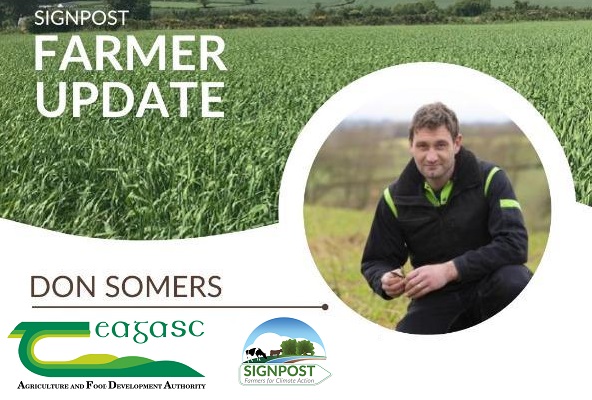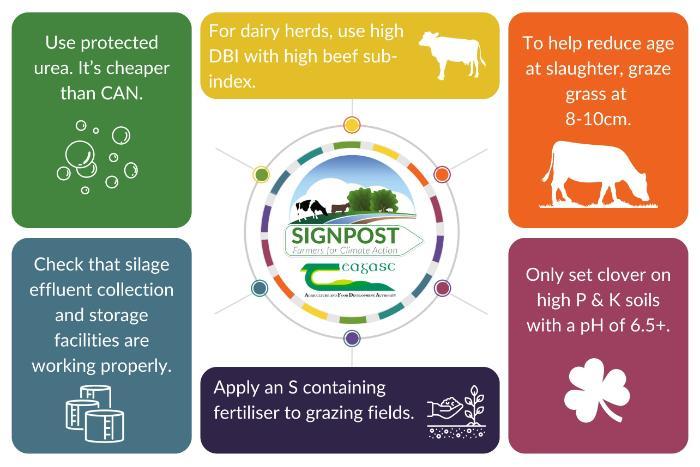06 May 2025
Signpost update: Spring crops established in excellent conditions

Don Somers, Signpost Tillage Farmer, talks us through the choices made on his farm in Co. Wexford this spring, where spring crops were established in exceptional conditions and organic manures are being used to supply key crop nutrients.
Spring crops were drilled into exceptional seedbeds. Once the good weather appeared, the temptation was to start drilling straight away. Thankfully, though, the long-term forecast was good – enabling soils to dry out and be cultivated in appropriate conditions. Soils required more work than normal to create a seedbed this year, due to poorly established cover crops following harvest 2024 and soils slumping following a particularly wet February.
Organic manures and fertiliser
All the spring barley and spring oats received 3.7 tonnes per hectare of layers manure, providing 33% of the nitrogen requirements and 75% of the phosphorus and potassium requirements.
While drilling the spring barley, I placed chemical fertiliser providing an additional 15% of the nitrogen requirement and the remaining 25% of the phosphorus and potassium requirement. The use of organic manure enables significant cost savings, while also adding organic matter to provide soil health benefits.
Fertiliser inputs represent a significant proportion of the cost of growing crops but are also the biggest driver of yield. Hence, there is no scope to compromise on fertiliser quality and its ability to be spread and deposited evenly within a field. The decision was made to use all complex compound fertiliser (CCF) this year, following mixed experiences with blended fertilisers in the past.
Weed control and BYDV
I had planned to use a pre-emergence herbicide on spring barley to control annual meadow grass and to get better control of speedwell, which has been more difficult to control in recent years. However soils were very dry following drilling, so I subsequently decided against using the pre-emerge product, as they require soil moisture to work effectively. Crop rotation has never been as important facilitating the use of herbicides with alternative modes of action and different active ingredients greatly reducing the risk of weeds becoming less sensitive to particular herbicides.
The risk of barley yellow dwarf virus was low to moderate this season given that my spring crops were all drilled in the first week of April and my land is a considerable distance from the coast. Given that the risk of barley yellow dwarf virus was not high, the decision was made not to apply an insecticide. If possible, my preference is not to use an insecticide to avoid killing non-aphid species some of which are actual predators of aphids.
Farming for Water European Innovation Partnership
My application for the Farming for Water European Innovation Partnership was recently approved. I chose the arable grass margin and cover crop measures within the scheme. The scheme is very flexible in that participants are not committed to drilling a given area of cover crop as in the case of ACRES. The area of cover crop drilled can range from 0 – 40 hectares depending on your circumstances within a given year. I am still awaiting payments for 2024 from the Department of Agriculture for schemes including ACRES, the straw incorporation measure and the baling assistance scheme. This created obvious cash flow issues resulting in having to acquire a larger stocking loan for 2025.
Teagasc Signpost May Climate Actions
Each month, the Teagasc Signpost Programme share key Climate Actions for the month ahead. For May, the actions include:
- Use protected urea. It’s cheaper than CAN;
- For dairy herds, use high DBI sires with high beef sub-index values;
- To help reduce age at slaughter, graze grass at 8-10cm;
- Only set clover on high P & K soils with a pH of 6.5+;
- Apply a fertiliser containing sulphur to grazing fields;
- Check that silage effluent collection and storage facilities are working properly.

Don Somers is a participant in the Teagasc Signpost Programme, find out more here.
The above was adapted for use from an article first published in the Farming Independent.
